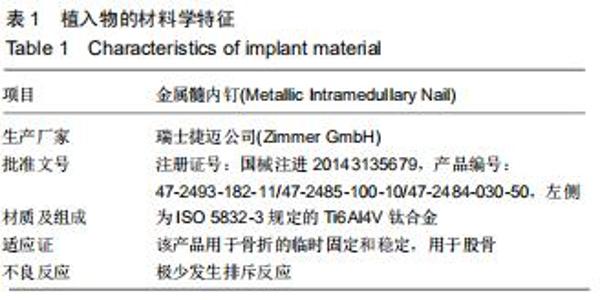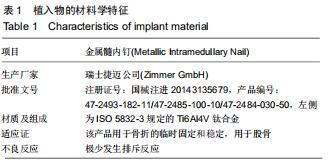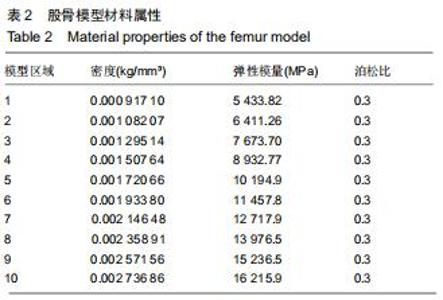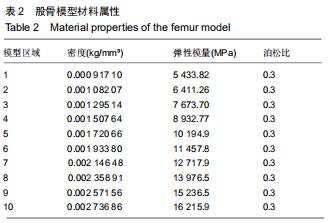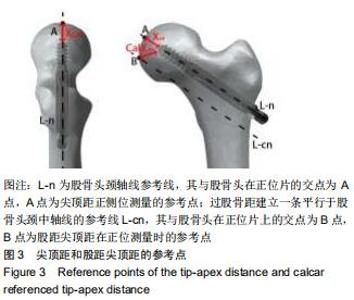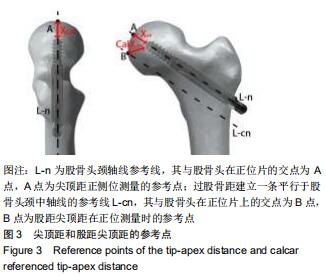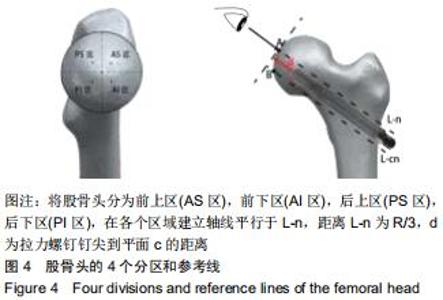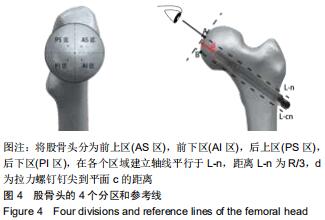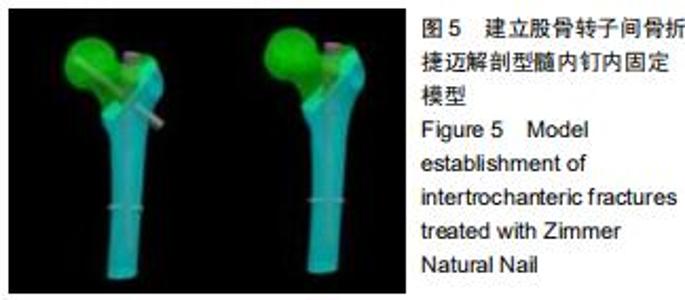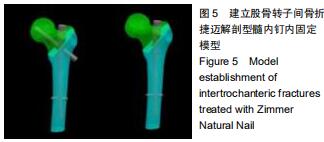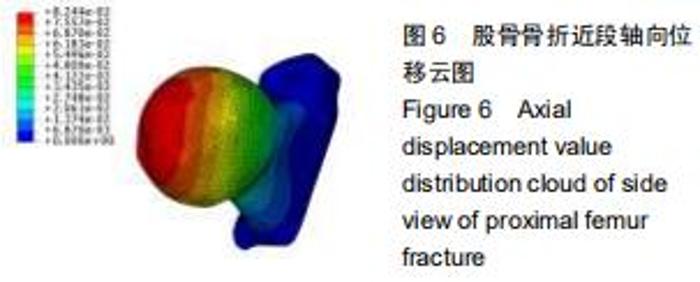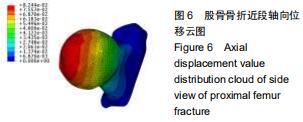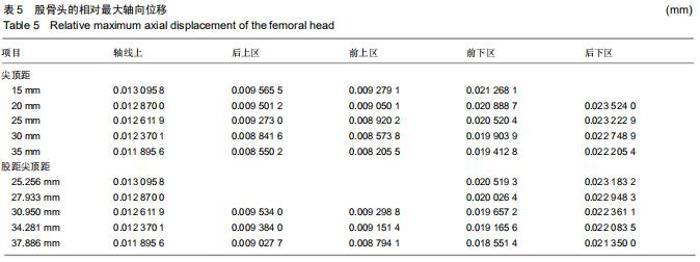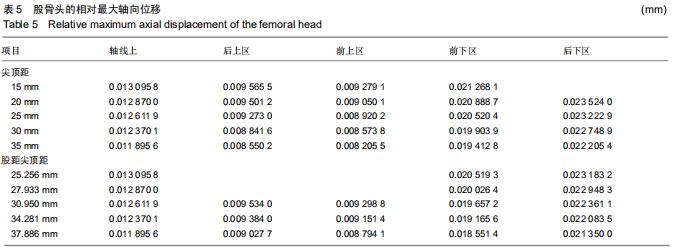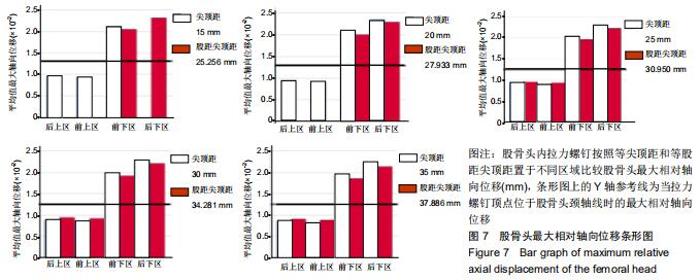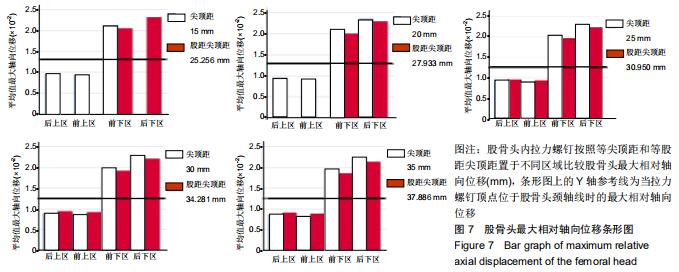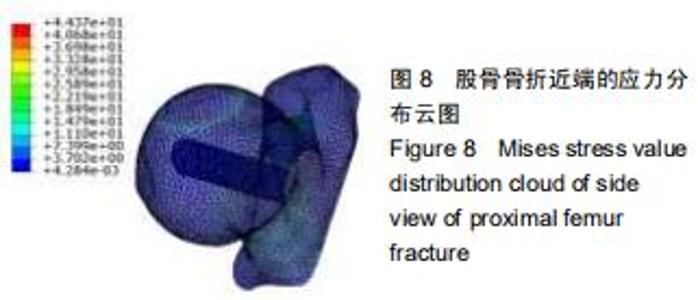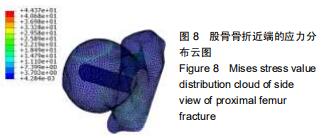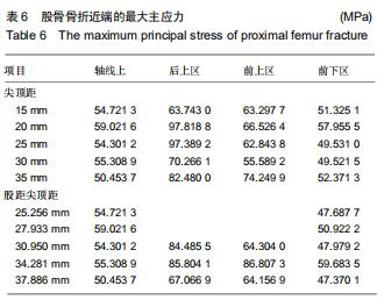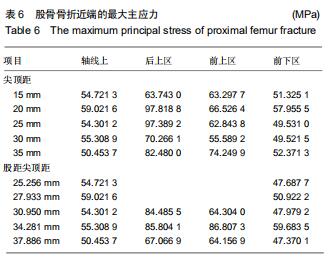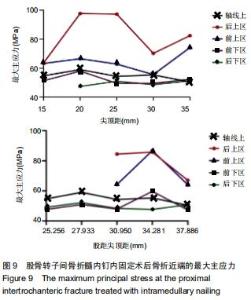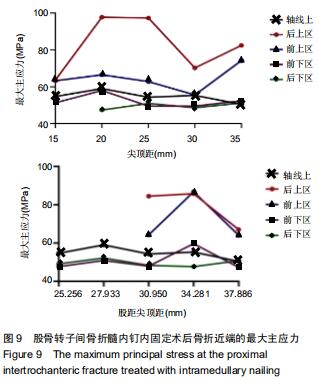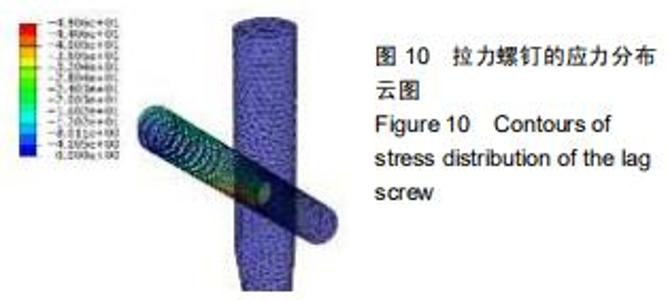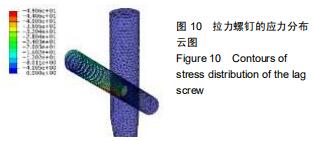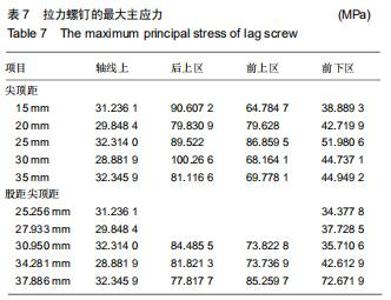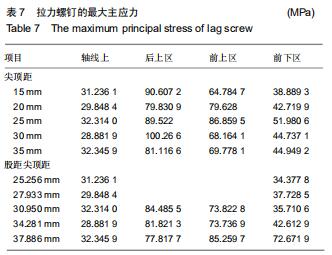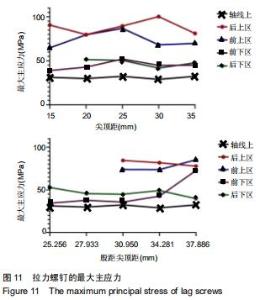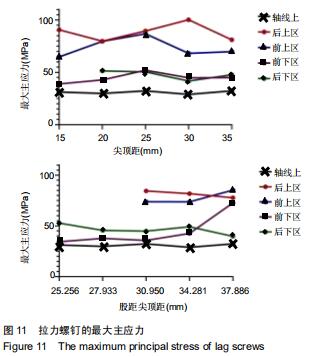Chinese Journal of Tissue Engineering Research ›› 2020, Vol. 24 ›› Issue (36): 5755-5763.doi: 10.3969/j.issn.2095-4344.2917
Previous Articles Next Articles
Effect of tip-apex distance and calcar referenced tip-apex distance on the stability of intertrochanteric fractures treated with cephalomedullary nailing assessed by the finite element method
Qiao Wen, Lü Xin, Liu Jinyuan, Zhang Jing, Li Yuanyuan, Kong Lingbao
- Department of Orthopedics, Second Hospital of Shanxi Medical University, Taiyuan 030000, Shanxi Province, China
-
Received:2020-03-16Revised:2020-03-20Accepted:2020-04-18Online:2020-12-28Published:2020-10-27 -
Contact:Lü Xin, Chief physician, Department of Orthopedics, Second Hospital of Shanxi Medical University, Taiyuan 030000, Shanxi Province, China -
About author:Qiao Wen, Master candidate, Department of Orthopedics, Second Hospital of Shanxi Medical University, Taiyuan 030000, Shanxi Province, China
CLC Number:
Cite this article
Qiao Wen, Lü Xin, Liu Jinyuan, Zhang Jing, Li Yuanyuan, Kong Lingbao. Effect of tip-apex distance and calcar referenced tip-apex distance on the stability of intertrochanteric fractures treated with cephalomedullary nailing assessed by the finite element method[J]. Chinese Journal of Tissue Engineering Research, 2020, 24(36): 5755-5763.
share this article
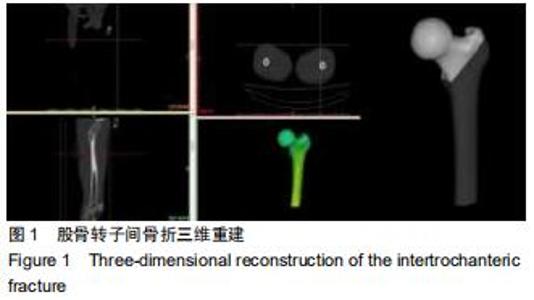
(2)建立成年男性股骨转子间骨折模型:将DIOCM文件导入Mimics软件(Materialise公司,比利时),使用Segment中的CT bone功能,选择左股骨,灰度值在400-2 199 HU之间,将长骨填充,得到左股骨Masks,使用segment中的Multiple Slice Edit和calculate Polylines功能对每一个股骨层面进行编辑,进一步通过人为判断,使股骨的每一个层面更加准确。然后利用3D计算功能,得到左侧股骨的粗糙三维模型,然后使用3D Tools中的Wrap和smooth对股骨模型进行进一步处理,得到光滑的左股骨三维模型(图1),然后将股骨模型以IGES格式导出。 "
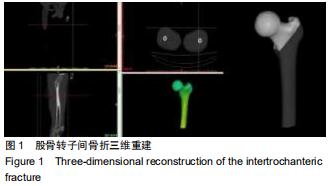
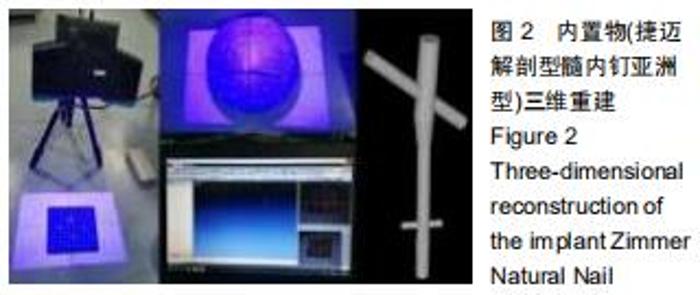
(2)建立内置物模型:将ASC文件导入Geomagic Wrap(Geomagic公司,美国)对文件进行重建,建立内置物的大体模型,使用捷迈公司提供的ZNN髓内钉数据尺寸,将模型导入UG中依据ZNN参数模型进一步完善,对远端锁定螺钉和ZNN拉力螺钉的螺纹进行简化处。该研究使用的ZNN模型尺寸:主钉近端直径15.5 mm,末端直径11.5 mm,主钉长度180 mm,前倾角15°,CCD角度125°,前弓弧度1 275 mm,4°近端外翻角,15°前倾角。拉力螺钉直径0.5 mm,螺纹部分27.5 mm,螺距3.75 mm。远端螺钉钉头低平,直径8 mm,螺钉直径5 mm,长度30 mm。将内置物模型以IGES文件进行保存。见图2。 "
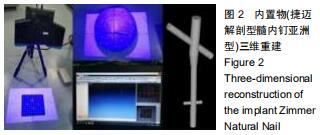
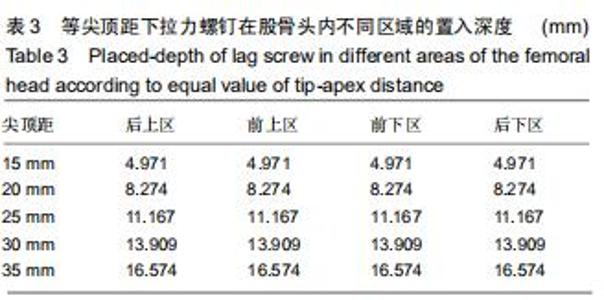
然后按照设定的尖顶距,将拉力螺钉的钉尖沿着4个区域建立的参考线置入,置入深度d与Xtad的关系为:Xtad= (d^2 + R^2/18)^(1/2) *2);使用MATLAB(MathWorks公司,美国)计算置入深度d(表3)。最后按照设定的股距尖顶距,将拉力螺钉的钉尖沿着4个区域建立的参考线置入,当拉力螺钉钉尖位于前上(AS区)和后上(PS)区时,置入深度d与股距尖顶距Xctad的关系为:Xctad=((x-7.486)^2+ (R/18^(1/2)+17.756)^2)^(1/2)+(x^2+ R^2/18)^(1/2)),当拉力螺钉位于前下(AI区)和后下(PI区)时,置入深度d和股距尖顶距Xctad的关系为:Xctad=((x-7.486)^2+(17.756-R/ 18^(1/2))^2)^(1/2)+(x^2+ R^2/18)^(1/2))。使用MATLAB计算置入深度d(表4)。 "
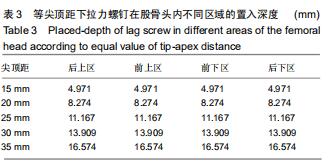
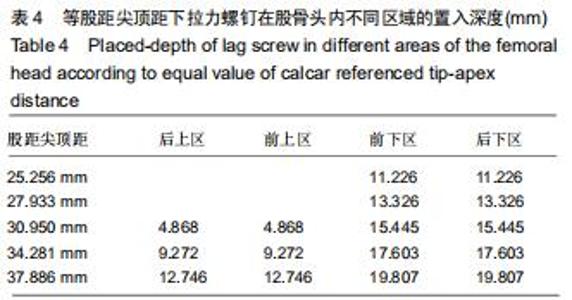
然后按照设定的尖顶距,将拉力螺钉的钉尖沿着4个区域建立的参考线置入,置入深度d与Xtad的关系为:Xtad= (d^2 + R^2/18)^(1/2) *2);使用MATLAB(MathWorks公司,美国)计算置入深度d(表3)。最后按照设定的股距尖顶距,将拉力螺钉的钉尖沿着4个区域建立的参考线置入,当拉力螺钉钉尖位于前上(AS区)和后上(PS)区时,置入深度d与股距尖顶距Xctad的关系为:Xctad=((x-7.486)^2+ (R/18^(1/2)+17.756)^2)^(1/2)+(x^2+ R^2/18)^(1/2)),当拉力螺钉位于前下(AI区)和后下(PI区)时,置入深度d和股距尖顶距Xctad的关系为:Xctad=((x-7.486)^2+(17.756-R/ 18^(1/2))^2)^(1/2)+(x^2+ R^2/18)^(1/2))。使用MATLAB计算置入深度d(表4)。 "
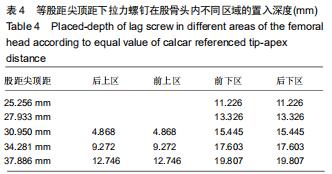
|
[1] VERONESE N, MAGGI S. Epidemiology and social costs of hip fracture. Injury.2018;49(8):1458-1460.
[2] GULLBERG B, JOHNELL O, KANIS JA. World-wide projections for hip fracture. Osteoporos Int. 1997;7(5):407-413.
[3] 张健,蒋协远,黄晓文.1139例老年髋部骨折治疗及流行病学分析[J].中国医刊,2016,51(6):91-94.
[4] MEREDDY P, KAMATH S, RAMAKRISHNAN M, et al. The AO/ASIF proximal femoral nail antirotation (PFNA): A new design for the treatment of unstable proximal femoral fractures. Injury. 2009;40(4):428-432.
[5] BOJAN AJ, BEIMEL C, SPEITLING A, et al. 3066 consecutive Gamma Nails. 12 years experience at a single centre. BMC Musculoskelet Disord.2010;11(1):133.
[6] HERZOG J, WENDLANDT R, HILLBRICHT S, et al. Optimising the tip-apex-distance in trochanteric femoral fracture fixation using the ADAPT-navigated technique, a longitudinal matched cohort study. Injury.2019;50(3):744-751.
[7] LOPES-COUTINHO L, DIAS-CARVALHO A, ESTEVES N, et al. Traditional distance "tip-apex" vs. new calcar referenced "tip-apex" - which one is the best peritrochanteric osteosynthesis failure predictor?. Injury.2020;51(3):674-677.
[8] BAUMGAERTNER MR, CURTIN SL, LINDSKOG DM, et al. The value of the tip-apex distance in predicting failure of fixation of peritrochanteric fractures of the hip. J Bone Joint Surg Am.1995; 77(7):1058-1064.
[9] CHANG SM, HOU ZY, HU SJ, et al. Intertrochanteric Femur Fracture Treatment in Asia: What We Know and What the World Can Learn.Orthop Clin North Am. 2020;51(2):189-205.
[10] GOFFIN JM, PANKAJ P, SIMPSON AH.The importance of lag screw position for the stabilization of trochanteric fractures with a sliding hip screw: a subject-specific finite element study. J Orthop Res. 2013;31(4):596-600.
[11] GÜVEN M, YAVUZ U, KADIOĞLU B, et al. Importance of screw position in intertrochanteric femoral fractures treated by dynamic hip screw. Orthop Traumatol Surg Res. 2010;96(1):21-27.
[12] KUZYK PR, ZDERO R, SHAH S, et al. Femoral head lag screw position for cephalomedullary nails: a biomechanical analysis. J Orthop Trauma. 2012;26(7):414-421.
[13] CARUSO G, BONOMO M, VALPIANI G, et al. A six-year retrospective analysis of cut-out risk predictors in cephalomedullary nailing for pertrochanteric fractures: Can the tip-apex distance (TAD) still be considered the best parameter. Bone Joint Res. 2017;6(8):481-488.
[14] BURKHART TA, ANDREWS DM, DUNNING CE. Finite element modeling mesh quality, energy balance and validation methods: a review with recommendations associated with the modeling of bone tissue. J Biomech. 2013;46(9):1477-1488.
[15] 张国栋,廖维靖,陶圣祥,等.股骨颈有限元分析的赋材料属性方法探讨及有效性验证[J].中国组织工程研究与临床康复,2009,13(52): 10263-10268.
[16] 姜自伟,虎群盛,黄枫,等.PFNA-Ⅱ治疗不稳定型股骨转子间骨折的动态有限元研究[J].山东医药,2016,56(33):14-17,21.
[17] 朱贵伟,吕欣,刘晋元,等.两种髓内钉治疗股骨转子间骨折的有限元分析[J].中华实验外科杂志,2017,34(8):1425. [18] LEE PY, LIN KJ, WEI HW, et al. Biomechanical effect of different femoral neck blade position on the fixation of intertrochanteric fracture: a finite element analysis. Biomed Tech (Berl). 2016;61(3): 331.
[19] LEE CH, SU KC, CHEN KH, et al. Impact of tip-apex distance and femoral head lag screw position on treatment outcomes of unstable intertrochanteric fractures using cephalomedullary nails. J Int Med Res. 2018;46(6):2128-2140.
[20] MORVAN A, BODDAERT J, COHEN-BITTAN J, et al. Risk factors for cut-out after internal fixation of trochanteric fractures in elderly subjects. Orthop Traumatol Surg Res. 2018;104(8):1183-1187.
[21] MURENA L, MORETTI A, MEO F, et al. Predictors of cut-out after cephalomedullary nail fixation of pertrochanteric fractures: a retrospective study of 813 patients. Arch Orthop Trauma Surg. 2018;138(3):351-359.
[22] 辛力,王业华,杨志.尖顶距对股骨粗隆间骨折动力髋螺钉内固定稳定性的相关有限元分析[J].徐州医学院学报,2013,33(12):821-824.
[23] KAUFER H. Mechanics of the treatment of hip injuries.Clin Orthop Relat Res. 1980;(146):53-61.
[24] DAVIS TR, SHER JL, HORSMAN A, et al. Intertrochanteric femoral fractures. Mechanical failure after internal fixation. J Bone Joint Surg Br. 1990;72(1):26-31.
[25] HSUEH KK, FANG CK, CHEN CM, et al. Risk factors in cutout of sliding hip screw in intertrochanteric fractures: an evaluation of 937 patients. Int Orthop. 2010;34(8):1273-1276.
[26] CLEVELAND M, BOSWORTH DM, THOMPSON FR, et al. A ten-year analysis of intertrochanteric fractures of the femur. J Bone Joint Surg Am. 1959;41-A:1399-1408.
[27] PARKER MJ. Cutting-out of the dynamic hip screw related to its position. J Bone Joint Surg Br.1992;74(4):625.
[28] DE BRUIJN K, DEN HARTOG D, TUINEBREIJER W, et al. Reliability of predictors for screw cutout in intertrochanteric hip fractures. J Bone Joint Surg Am. 2012;94(14):1266-1272.
[29] MINGO-ROBINET J, TORRES-TORRES M, MARTÍNEZ-CERVELL C, et al. Comparative study of the second and third generation of gamma nail for trochanteric fractures: review of 218 cases. J Orthop Trauma. 2015;29(3):e85-e90.
[30] HERMAN A, LANDAU Y, GUTMAN G, et al.Radiological evaluation of intertrochanteric fracture fixation by the proximal femoral nail. Injury. 2012;43(6):856-863.
[31] KANE P, VOPAT B, HEARD W, et al. Is tip apex distance as important as we think? A biomechanical study examining optimal lag screw placement. Clin Orthop Relat Res. 2014;472(8):2492-2498.
[32] KASHIGAR A, VINCENT A, GUNTON MJ, et al. Predictors of failure for cephalomedullary nailing of proximal femoral fractures. Bone Joint J. 2014;96-B(8):1029-1034.
[33] AICALE R, MAFFULLI N.Greater rate of cephalic screw mobilisation following proximal femoral nailing in hip fractures with a tip-apex distance (TAD) and a calcar referenced TAD greater than 25 mm. J Orthop Surg Res. 2018;13(1):106.
[34] BREKELMANS WA, POORT HW, SLOOFF TJ. A new method to analyse the mechanical behaviour of skeletal parts. Acta Orthop Scand. 1972;43(5):301-317.
[35] KEYAK JH, ROSSI SA, JONES KA, et al. Prediction of fracture location in the proximal femur using finite element models. Med Eng Phys. 2001;23(9):657-664.
[36] VAN DEN MUNCKHOF S, ZADPOOR AA. How accurately can we predict the fracture load of the proximal femur using finite element models? Clin Biomech(Bristol, Avon). 2014;29(4):373-380.
[37] LI S, CHANG SM, JIN YM, et al. A mathematical simulation of the tip-apex distance and the calcar-referenced tip-apex distance for intertrochanteric fractures reduced with lag screws. Injury. 2016; 47(6):1302-1308. |
| [1] | Zhong Yizheng, Huang Peizhen, Cai Qunbin, Zheng Liqin, He Xingpeng, Dong Hang. Microstructural indexes that determine the trabecular bone maximum stress of micro-finite element models [J]. Chinese Journal of Tissue Engineering Research, 2023, 27(9): 1313-1318. |
| [2] | Liu Xinyue, Xing Xinyang, Huo Hongfeng. Differences in human dynamic stability during walking under different cognitive loads [J]. Chinese Journal of Tissue Engineering Research, 2023, 27(9): 1335-1339. |
| [3] | Peng Zhixin, Yan Wengang, Wang Kun, Zhang Zhenjiang. Finite element analysis and structural optimization design of 3D printed forearm braces [J]. Chinese Journal of Tissue Engineering Research, 2023, 27(9): 1340-1345. |
| [4] | Wu Tianliang, Tao Xiuxia, Xu Hongguang. Influence of different bone mineral densities on cage subsidence after stand-alone oblique lateral interbody fusion: three-dimensional finite element analysis [J]. Chinese Journal of Tissue Engineering Research, 2023, 27(9): 1352-1358. |
| [5] | Liu Jinyu, Zhang Hanshuo, Cui Hongpeng, Pan Lingzhi, Zhao Boran, Li Fei, Ding Yu. Finite element biomechanical analysis of minimally invasive treatment of cervical spondylotic myelopathy and accurate exercise rehabilitation [J]. Chinese Journal of Tissue Engineering Research, 2023, 27(9): 1359-1364. |
| [6] | He Yujie, Kang Zhijie, Xue Mingming, Jin Feng, Li Zhijun, Wang Xing, Xu Yangyang, Gao Mingjie, Li Jiawei, Li Xiaohe, Wang Haiyan. Finite element analysis of transarticular screw fixation of adolescent thoracic vertebra [J]. Chinese Journal of Tissue Engineering Research, 2023, 27(9): 1365-1370. |
| [7] | Wen Xinghua, Ding Huanwen, Cheng Kai, Yan Xiaonan, Peng Yuanhao, Wang Yuning, Liu Kang, Zhang Huiwu. Three-dimensional finite element model analysis of intramedullary nailing fixation design for large femoral defects in Beagle dogs [J]. Chinese Journal of Tissue Engineering Research, 2023, 27(9): 1371-1376. |
| [8] | Zheng Bo, Zhang Xiuli, Zhou Hao, He Zebi, Zhou Jin, Zhou Weiyun, Li Peng. Arthroscopy-assisted locking hollow screw fixation and open reduction plate internal fixation in the treatment of Schatzker II-III tibial plateau fractures: early CT evaluation [J]. Chinese Journal of Tissue Engineering Research, 2023, 27(9): 1410-1416. |
| [9] | Dang Yi, Du Chengyan, Yao Honglin, Yuan Nenghua, Cao Jin, Xiong Shan, Zhang Dingmei, Wang Xin. Hormonal osteonecrosis and oxidative stress [J]. Chinese Journal of Tissue Engineering Research, 2023, 27(9): 1469-1476. |
| [10] | Sun Jiajia, Zhu Haidi, Lu Yun, Zhang Kai. Comparison of bone metabolism markers between type 2 diabetes mellitus and non-type 2 diabetes mellitus patients with hip fracture [J]. Chinese Journal of Tissue Engineering Research, 2023, 27(8): 1156-1160. |
| [11] | Huang Linke, Wei Linhua, Jiang Jie, Liu Qian, Chen Weiwei. Effects of estrogen combined with treadmill exercise on bone mass and articular cartilage in ovariectomized mice [J]. Chinese Journal of Tissue Engineering Research, 2023, 27(8): 1166-1171. |
| [12] | Yang Zhishan, Tang Zhenglong. YAP/TAZ, a core factor of the Hippo signaling pathway, is involved in bone formation [J]. Chinese Journal of Tissue Engineering Research, 2023, 27(8): 1264-1271. |
| [13] | Bai Yulong, Li Zhonghai, Zhao Yantao, Xia Cencan, Shi Lei. History, current situation and prospect of tissue banks in China [J]. Chinese Journal of Tissue Engineering Research, 2023, 27(8): 1306-1312. |
| [14] | Liu Jiaxin, Jia Peng, Men Yutao, Liu Lu, Wang Yeming, Ye Jinduo. Design and optimization of bone trabecular structure with triply periodic minimal surfaces [J]. Chinese Journal of Tissue Engineering Research, 2023, 27(7): 992-997. |
| [15] | Yuan Hucheng, Ding Yongguo, Ma Xuehua, Ma Wenxin, Sun Jianmin, Wang Zili, Jin Weidong. Sustained releasing of pyrazinamide, capreomycin, moxifloxacin and amikacin loaded bone cement in vitro [J]. Chinese Journal of Tissue Engineering Research, 2023, 27(7): 1017-1022. |
| Viewed | ||||||
|
Full text |
|
|||||
|
Abstract |
|
|||||
